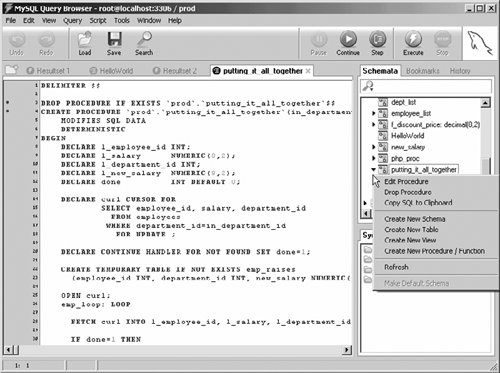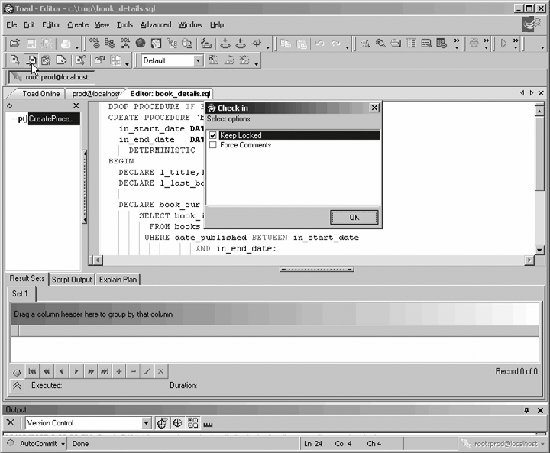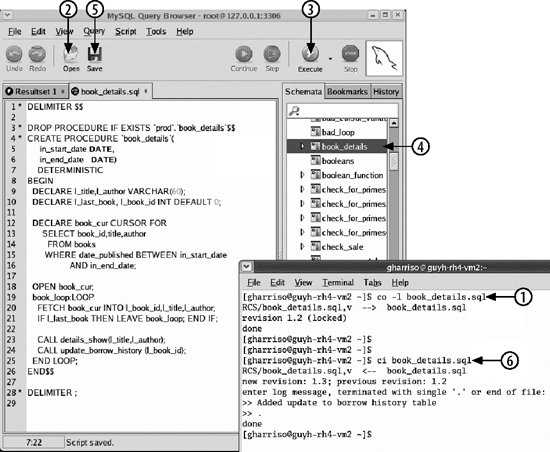Editing an Existing Stored Program
There are two approaches to editing the text of existing stored programs. The easiest though probably not the bestway to edit an existing stored program is to use the MySQL Query Browser to edit the stored program in place. By "in place," we mean that you work directly with the copy of the stored program held in the database. A better way is to edit an external text file that contains the stored procedure code. We describe these approaches in the following subsections.
7.2.1. Editing a Program in Place
Editing a stored program in place is certainly easy, as shown in Figure 7-8. To edit an existing stored program in this way, you simply locate and select the stored program in the MySQL Query Browser's Schemata browser, right-click, and select Edit Procedure (or Edit Function) from the context menu. The relevant stored program code is loaded from the database into the edit window where you can make your changes. Clicking the Execute button runs the modified script and replaces the stored program in the database.
Figure 7-8. Editing a stored program in place with the MySQL Query Browser

7.2.2. Maintaining Stored Programs in External Files
There are a number of reasons why you may not want to edit stored programs in place, as we did in Figure 7-8:
- When you retrieve the text for a stored program from the database (as Query Browser and other similar programs do), you may find that the text of the stored program is slightly different from the version you originally created. In particular, the name of the stored routine may be quoted and the name of the database prepended. This prepending of the database name is a bad idea if you want to migrate stored programs to other databases.
- It is definitely best practice to use a source control system (such as Microsoft SourceSafe, Subversion, or CVS) to store each changed iteration of your stored program. This allows you to roll back changes to a stored program that turn out to be problematic, and allows you to retrieve a specific version of a program when multiple versions are in use.
Some third-party MySQL development tools allow you to load and save your stored program source directly into a version control system such as CVS. For instance, in Toad for MySQL we can check files in and out of CVS or SourceSafe from within our programming environment, as shown in Figure 7-9.
Figure 7-9. Toad for MySQL provides integration with version control systems

Regardless of whether your IDE directly supports integration with a version control system, you should still use version control to maintain stored program code. Rather than extract the stored program code from the database, you will extract it from an external file before editing, and you will save the external fileand check it into your version control systemwhen it is complete.
Figure 7-10 shows how we can perform these actions on a Linux system using the MySQL Query Browser as our editing environment and RCS as our version control system.
Figure 7-10. Maintaining stored program source code in a source control system

Let's work through the steps highlighted in Figure 7-10:
- Before we get started, we need to extract the source file from the version control system and lock it for editing. In the RCS system this is done with the co -l command.
- Now we can load the source file into an edit window in the MySQL Query Browser.
- After making our edits, we can save our changes to the database by clicking the Execute button.
- We can perform basic testing of the stored program by running it from within the Query Browser. Double-clicking the stored program name in the Schemata browser is one way to do this.
- If we are satisfied that our changes are good, we can save them back to the disk file we originally loaded.
- Now we check the changes back into version control. In RCS this is done with the ci command.
Part I: Stored Programming Fundamentals
Introduction to MySQL Stored Programs
- Introduction to MySQL Stored Programs
- What Is a Stored Program?
- A Quick Tour
- Resources for Developers Using Stored Programs
- Some Words of Advice for Developers
- Conclusion
MySQL Stored Programming Tutorial
- MySQL Stored Programming Tutorial
- What You Will Need
- Our First Stored Procedure
- Variables
- Parameters
- Conditional Execution
- Loops
- Dealing with Errors
- Interacting with the Database
- Calling Stored Programs from Stored Programs
- Putting It All Together
- Stored Functions
- Triggers
- Calling a Stored Procedure from PHP
- Conclusion
Language Fundamentals
- Language Fundamentals
- Variables, Literals, Parameters, and Comments
- Operators
- Expressions
- Built-in Functions
- Data Types
- MySQL 5 Strict Mode
- Conclusion
Blocks, Conditional Statements, and Iterative Programming
- Blocks, Conditional Statements, and Iterative Programming
- Block Structure of Stored Programs
- Conditional Control
- Iterative Processing with Loops
- Conclusion
Using SQL in Stored Programming
- Using SQL in Stored Programming
- Using Non-SELECT SQL in Stored Programs
- Using SELECT Statements with an INTO Clause
- Creating and Using Cursors
- Using Unbounded SELECT Statements
- Performing Dynamic SQL with Prepared Statements
- Handling SQL Errors: A Preview
- Conclusion
Error Handling
- Error Handling
- Introduction to Error Handling
- Condition Handlers
- Named Conditions
- Missing SQL:2003 Features
- Putting It All Together
- Handling Stored Program Errors in the Calling Application
- Conclusion
Part II: Stored Program Construction
Creating and Maintaining Stored Programs
- Creating and Maintaining Stored Programs
- Creating Stored Programs
- Editing an Existing Stored Program
- SQL Statements for Managing Stored Programs
- Getting Information About Stored Programs
- Conclusion
Transaction Management
- Transaction Management
- Transactional Support in MySQL
- Defining a Transaction
- Working with Savepoints
- Transactions and Locks
- Transaction Design Guidelines
- Conclusion
MySQL Built-in Functions
- MySQL Built-in Functions
- String Functions
- Numeric Functions
- Date and Time Functions
- Other Functions
- Conclusion
Stored Functions
- Stored Functions
- Creating Stored Functions
- SQL Statements in Stored Functions
- Calling Stored Functions
- Using Stored Functions in SQL
- Conclusion
Triggers
Part III: Using MySQL Stored Programs in Applications
Using MySQL Stored Programs in Applications
- Using MySQL Stored Programs in Applications
- The Pros and Cons of Stored Programs in Modern Applications
- Advantages of Stored Programs
- Disadvantages of Stored Programs
- Calling Stored Programs from Application Code
- Conclusion
Using MySQL Stored Programs with PHP
- Using MySQL Stored Programs with PHP
- Options for Using MySQL with PHP
- Using PHP with the mysqli Extension
- Using MySQL with PHP Data Objects
- Conclusion
Using MySQL Stored Programs with Java
- Using MySQL Stored Programs with Java
- Review of JDBC Basics
- Using Stored Programs in JDBC
- Stored Programs and J2EE Applications
- Using Stored Procedures with Hibernate
- Using Stored Procedures with Spring
- Conclusion
Using MySQL Stored Programs with Perl
- Using MySQL Stored Programs with Perl
- Review of Perl DBD::mysql Basics
- Executing Stored Programs with DBD::mysql
- Conclusion
Using MySQL Stored Programs with Python
- Using MySQL Stored Programs with Python
- Installing the MySQLdb Extension
- MySQLdb Basics
- Using Stored Programs with MySQLdb
- A Complete Example
- Conclusion
Using MySQL Stored Programs with .NET
- Using MySQL Stored Programs with .NET
- Review of ADO.NET Basics
- Using Stored Programs in ADO.NET
- Using Stored Programs in ASP.NET
- Conclusion
Part IV: Optimizing Stored Programs
Stored Program Security
- Stored Program Security
- Permissions Required for Stored Programs
- Execution Mode Options for Stored Programs
- Stored Programs and Code Injection
- Conclusion
Tuning Stored Programs and Their SQL
- Tuning Stored Programs and Their SQL
- Why SQL Tuning Is So Important
- How MySQL Processes SQL
- SQL Tuning Statements and Practices
- About the Upcoming Examples
- Conclusion
Basic SQL Tuning
Advanced SQL Tuning
- Advanced SQL Tuning
- Tuning Subqueries
- Tuning Anti-Joins Using Subqueries
- Tuning Subqueries in the FROM Clause
- Tuning ORDER and GROUP BY
- Tuning DML (INSERT, UPDATE, DELETE)
- Conclusion
Optimizing Stored Program Code
- Optimizing Stored Program Code
- Performance Characteristics of Stored Programs
- How Fast Is the Stored Program Language?
- Reducing Network Traffic with Stored Programs
- Stored Programs as an Alternative to Expensive SQL
- Optimizing Loops
- IF and CASE Statements
- Recursion
- Cursors
- Trigger Overhead
- Conclusion
Best Practices in MySQL Stored Program Development
EAN: 2147483647
Pages: 208
